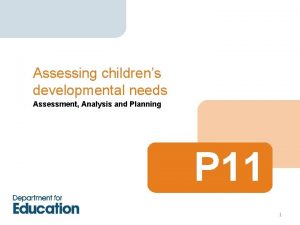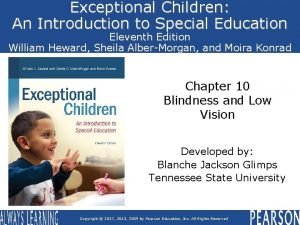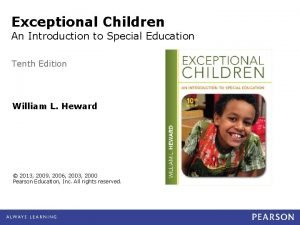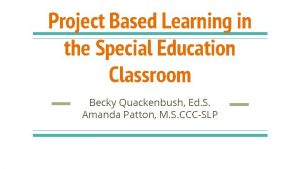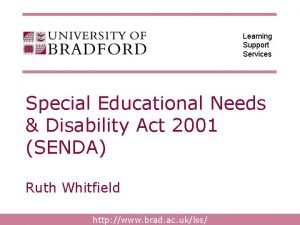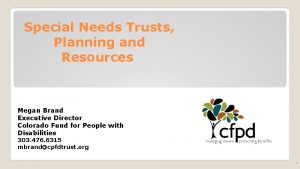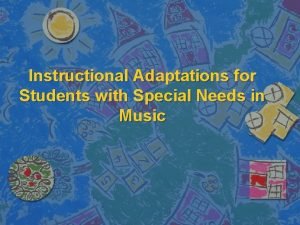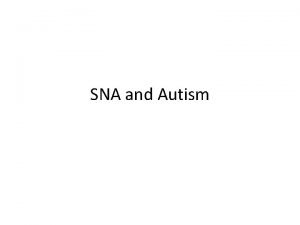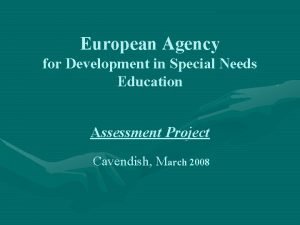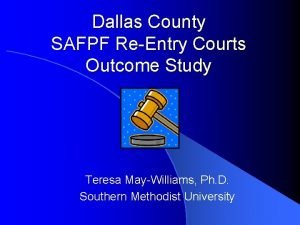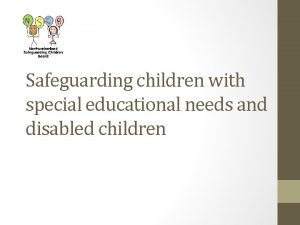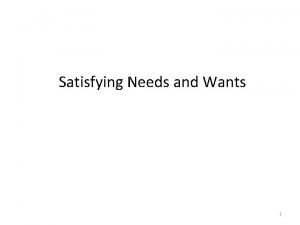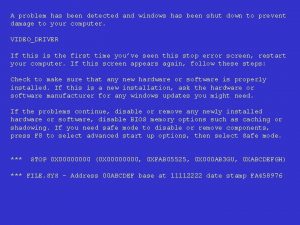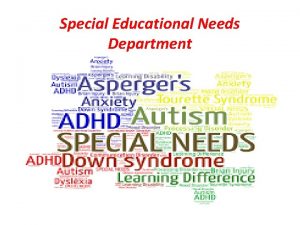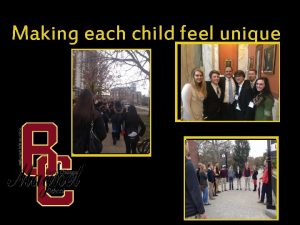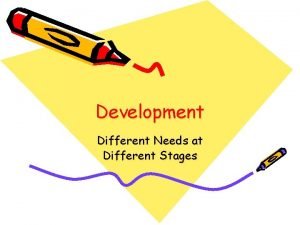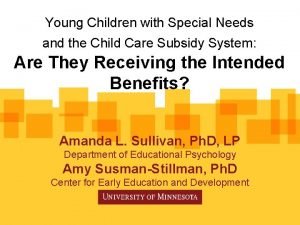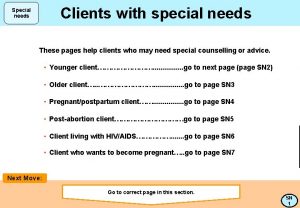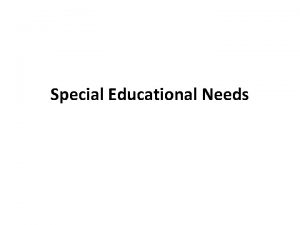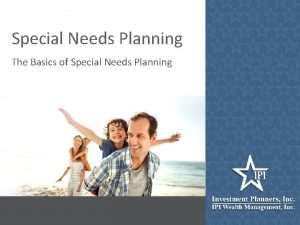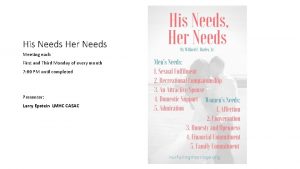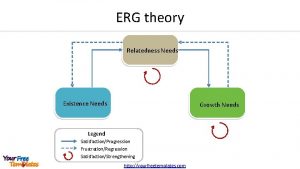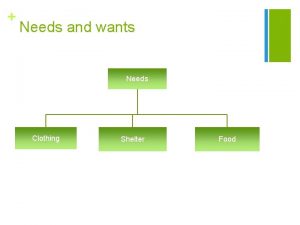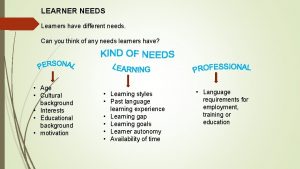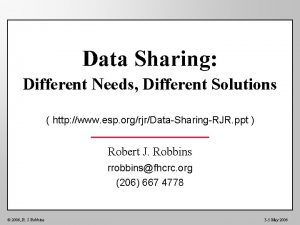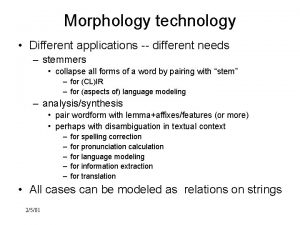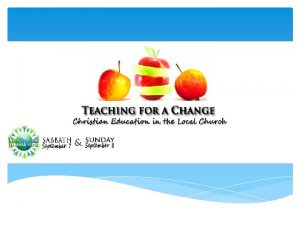SPECIAL NEEDS CHILDREN EACH CHILD HAS DIFFERENT SPECIAL



































- Slides: 35

• SPECIAL NEEDS CHILDREN: EACH CHILD HAS DIFFERENT SPECIAL NEEDS • ➤ Children with special needs may have: • mild learning disabilities • profound cognitive impairment • food allergies • serious illness • physical disorders • language difficulties • emotional problems

• SPECIAL NEEDS CHILDREN: EACH CHILD HAS DIFFERENT SPECIAL NEEDS • ➤ Children with special needs may have: • mild learning disabilities • profound cognitive impairment • food allergies • serious illness • physical disorders • language difficulties • emotional problems

SPECIAL NEEDS CHILDREN: TEACHER AS A MEDIATOR

SPECIAL NEEDS CHILDREN: DIFFERENTIATING INSTRUCTION • ➤ Differentiated instruction • (also known as differentiated learning or, in education, simply, differentiation) • ➤ Providing different students with different avenues to learning

SPECIAL NEEDS CHILDREN: INCLUSION ➤ Inclusion: ➤ Disabled people of all ages and/or those learners with 'Special Educational Needs' labels being educated in mainstream education settings alongside their nondisabled peers, where there is a commitment to removing all barriers to the full participation of everyone as equally valued and unique individuals. ➤ Education for ALL!

Information easy to read and understand Mgr. Magdaléna Olšinská

specific learning difficulty • good IQ (70 -130) • reading (dyslexia) • mathematics (dyscalculia) • writing (dysgraphia) • Atention disorder with hyperactivity ADHD learning disability • reduced intellectual ability • IQ < 70 • mild learning disability: difficulty to understand complex information, • moderate: needs help with every day tasks • profound: full-time care and support with every aspect of their life

Information

Why do we need easy to understand information? Convention on the rights of persons with disabilities, 2006 • People with intellectual disabilities need to have an access to information • Good information helps people find out what they need to know. It helps them to make their own choices and decisions.

People with learning disability, autism, dyslexia, with different language, hearing and sight problems

Easy to read information online: health information - medical services, benefits – social service human rights – politic topic Easy to read information at school: -Instruction -Rules at school -Learning materials

For the tomato sauce, peel and finely slice the garlic, then fry in a good amount of olive oil until lightly coloured. Pick and tear the basil leaves, then add to the pan with the tomatoes. Using the back of a wooden spoon, mush and squash the tomatoes as much as you can. Season to taste. As soon as it comes to the boil, remove the pan from the heat. Strain the sauce through a coarse sieve into a bowl, using the spoon to push any larger bits of tomato through. Discard the basil and garlic left in the sieve, but scrape any tomatoe goodness off the back of the sieve into the bowl. Pour the sauce back into the pan, bring to the boil, then lower the heat and simmer for 5 minutes. Cook until it’s the perfect consistency for spreading on your pizza bases. For the pizza dough, sieve the flour and salt onto a clean work surface and make a well in the middle. In a jug, mix the yeast, sugar and olive oil into 650 ml lukewarm water and leave for a few minutes, then pour into the well. Using a fork, bring the flour in gradually from the sides and swirl it into the liquid. When it all starts to come together, work the rest of the flour in with your clean hands. Knead until you have a smooth, springy dough. Place the ball of dough in a large flourdusted bowl and cover with a damp cloth and place in a warm room for an hour until the dough has doubled in size. Remove the dough to a flour-dusted surface and knead it around a bit to push the air out. You can use it immediately, or keep it, wrapped in clingfilm, in the fridge (or freezer) until required. If using straight away, divide the dough up into 6 to 8 balls. Timing-wise, it’s a good idea to roll the pizza bases out about 15 to 20 minutes before you want to cook them. Stack the pizza bases, with a square of oiled tin foil between each one, cover them with clingfilm, and pop them into the fridge. Now’s the time to get your wood-fired oven, or conventional oven, heated up to full whack. Place a couple of heavy baking trays in the oven to heat up, too. Meanwhile, click off the broccoli florets and roughly chop (using the stalk, too). Blanch in boiled salted water for 1 to 2 minutes, then drain. Tear the anchovies into small pieces, then deseed and finely chop the chilli. Squeeze the sausage meat out of their skins, then roll into small, rough meatballs. When you’re ready to assemble your pizzas, remove a tray from the oven, put a pizza base on it and assemble it quickly – smear tomato sauce on the base and dot with broccoli, torn up anchovy fillets and sausage meatballs. Tear over the Taleggio cheese and sprinkle with chilli. Crush and scatter over the fennel seeds. Place in the oven immediately while you prepare the remaining pizzas. If you’re using a wood-fired oven the pizzas should cook, one by one, in about 3 to 4 minutes – you want them to be puffed up, crispy and delicious. In a regular oven, they’ll take 8 to 10 minutes. Serve hot. http: //www. jamieoliver. com/

• Use colour which is clearly seen at backgrounds • Never use a picture as a background • Never use a special writing design or italic • At least the size of Arial 14.

MOTHER Times new Roman MOTHER Arial Always use a font that is clear and easy to read. A font is a type of writing. For example good to read is: - Arial - Tahoma - Calibri

How to make this information easier to understand? Transport Company are authorised to perform inspection of adherence to Transport Terms of Service and the PIT Tariff in the operation of the metro, trams, the funicular and PIT buses. A transit inspector identifies himself with an inspector's badge belonging to the Prague Public Transport Company; upon request also with his company identification with photograph and number identical to the number of the inspector's badge.

Inspection at Prague transport If you travel by bus, tram or metro, you need to buy a ticket. When you enter the bus, put the ticket into yelow marker and mark it. An inspector can check your ticket. If you do not have valid ticket, you have to pay fine.

Keep sentences short! • Always start a new sentence on a new line. Never split 1 word over 2 lines. • Highlight the important information in bold • Do not put too much text on your page. • Leave space between paragraphs. • Give only the important information

• Speak to people directly. Use words like “you” to do this. • Be careful when you use pronouns like “I”, “him” or “it”. • Use the proper name instead. • repeat important information.

easy to understand words • examples that people will know from their everyday lives. • Use the same word to describe the same thing • Do not use words from other languages • Do not use difficult words. If you need to use difficult words, make sure you always explain them clearly.

discrimination Discrimination means that somebody is unfair to you. Or that somebody threats you differently, just because you have some disability.

It is raining cats and dogs… Do not use difficult ideas such as metaphors.

EU • Avoid using initials. Initials are the first letter of every word. Use the word in full where possible. • If you have to use initials, explain them. For example, if you write “EU”, explain that it stands for “the European Union

Percentages (63%), big numbers (1, 758, 625) • Try not to use percentages and big numbers. Instead, use words like “few” and “many” to explain what you mean.

“you will be sent a letter”. • active language is better: • “The doctor will send you a letter”

“You should not leave before the end of the meeting”. • Use positive sentences: • “You should stay until the end of the meeting”

Clear structure Yesterday, I bought a green/yellow bike (a new one!) for my son – whose name is Michael. My son’s name is Michael. Yesterday, I bought a new bike for him. The new bike is green and yellow.

Images • Many people find it hard to read text. To help them understand your text, you should put images next to it to describe what it is about. • photographs, drawings, or symbols

CYCLIST Which picture is better? Why?

pictures • try to use the same style of images • always choose images that are clear • never use images for children when you are writing for adults.

European easy-to-read logo • Your document must be written according to the rules called the European standards for making information easy to read and understand. • At least 1 person with intellectual disability read your document and said it was easy to read and understand. http: //easy-to-read. eu/? page_id=20

Task: make easy to read recipe Work 2 together. You can write in your language. For example: make a sandwich / a cup of the tea. Use clear structure! 1) 2) 3)

Picto selector


Web sites • http: //www. easy-to-read. eu/ - principles • http: //www. pecsforall. com/ - pictoselector • http: //www. easyhealth. org. uk/ - examples • http: //smartourismguide. com/ tourist information • https: //www. mencap. org. uk/definition

 Friends of children with special needs
Friends of children with special needs Unit 18 assessing children's development support needs
Unit 18 assessing children's development support needs Primary needs and secondary needs
Primary needs and secondary needs Satisfaction
Satisfaction Simple claustral complex
Simple claustral complex Strategic gender needs and practical gender needs
Strategic gender needs and practical gender needs Types of need analysis in esp
Types of need analysis in esp Child's developmental needs triangle
Child's developmental needs triangle Exceptional children 11th edition
Exceptional children 11th edition Exceptional children an introduction to special education
Exceptional children an introduction to special education 전위 순회
전위 순회 Project based learning for special education
Project based learning for special education Elderplan plan materials
Elderplan plan materials Teachwise app
Teachwise app Special educational needs and disability act 2001
Special educational needs and disability act 2001 Special needs trust virginia
Special needs trust virginia Colorado special needs trust
Colorado special needs trust Instructional adaptations for special needs students
Instructional adaptations for special needs students Special needs summer cmap
Special needs summer cmap The role of the sna
The role of the sna European agency for development in special needs education
European agency for development in special needs education Safpf dallas county
Safpf dallas county Safeguarding special needs
Safeguarding special needs Chapter 8 persepolis
Chapter 8 persepolis Satisfying needs chap 6
Satisfying needs chap 6 A problem has
A problem has A problem has been detected
A problem has been detected No child left behind act special education
No child left behind act special education No child left behind act special education
No child left behind act special education Thermosoftening plastics examples
Thermosoftening plastics examples Why do different atoms produce different colors
Why do different atoms produce different colors Sound will travel at different speeds in different mediums.
Sound will travel at different speeds in different mediums. Sound will travel at different speeds in different mediums.
Sound will travel at different speeds in different mediums. What is cultural relativism
What is cultural relativism Different angle different story
Different angle different story Acids and bases song lyrics
Acids and bases song lyrics







